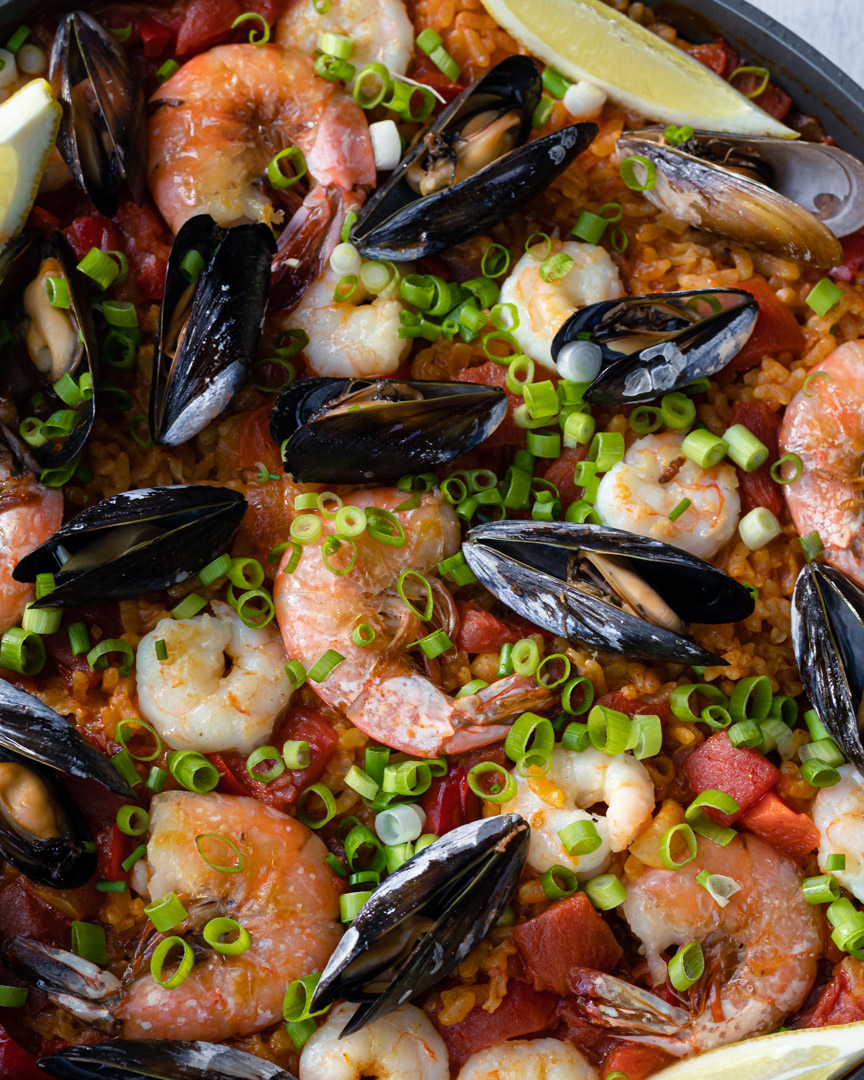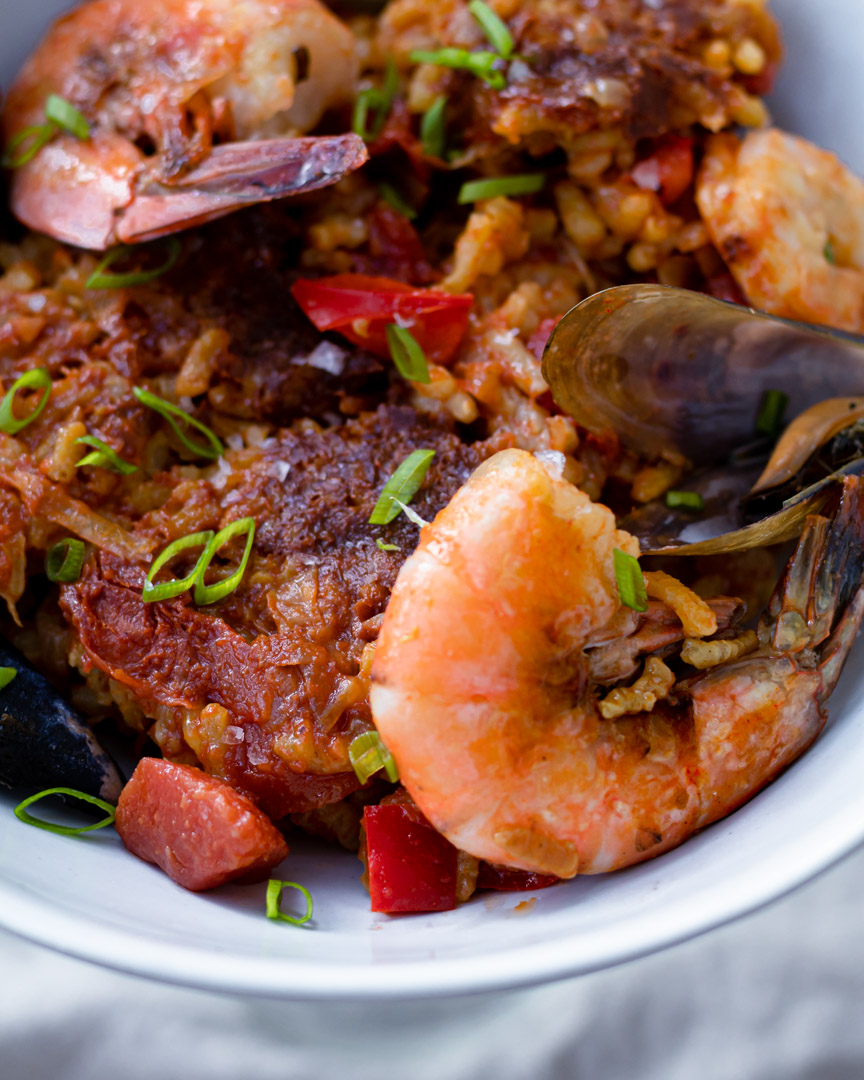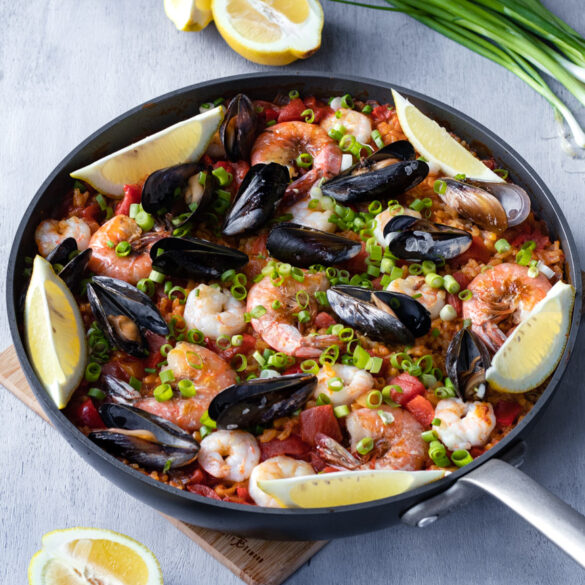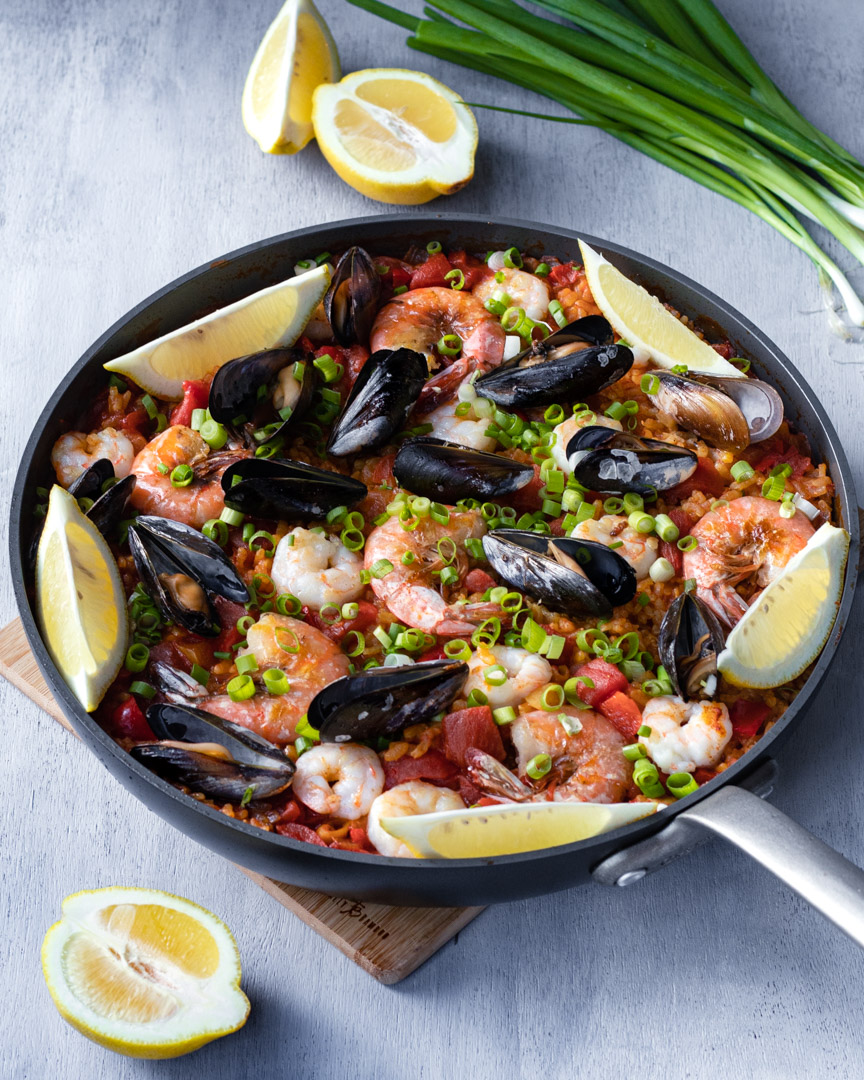Ten years ago I got super lucky to learn an amazing paella recipe and many of paella’s secrets directly from a Valencian chef. It was love from first sight (not with the chef tho, but with paella).
It’s a widely known fact that Valencia is considered to be paella’s birthplace. Original paella Valenciana recipe, however, didn’t consist of any seafood. Only chicken, rabbit and beans (and rice, of course). Eventually, restaurant marketing turned it into more luxurious (read – expensive) dish by adding seafood to it. Nowadays paella offers include all kinds of crustaceans and molluscs one can possibly imagine. Langoustines, lobster, even oysters – they’ve all been there.

Chef’s seafood paella recipe didn’t include any lobster or such but was delicious nonetheless. And, although I love altering recipes to make them my own, I didn’t change much in it over past ten years.
What I did, however, is figured out how to make that seafood paella recipe foolproof and easy to work with. I also started adding chorizo. Chorizo instantly makes everything taste better so I thought – why not.
My easy seafood paella recipe tips and tricks:
- If for any reason you choose not to use chorizo – make sure to slightly oversalt your broth and veggies. Yup! You read it right. We can’t really salt our rice, nor we can check how well the rice itself is seasoned in the beginning of the process (who wants to crunch on raw rice?). However, it will expand and soak in saltiness of other ingredients. That is to say – whatever felt perfectly salted in the beginning will most likely taste bland in the end.
- A squeeze of lemon juice on top of finished paella is must, yes. But adding some lemon juice (1/2 lemon per 1 qt) directly into the broth will take your paella to the whole different level.
- Use only round short-grain rice. Ideally – spanish “bomba”, but arborio and carnaroli will do too.
- “Under penalty and perjury, don’t stir the rice after the broth is added”, they said. I do agree with this statement. High starch content of round short-grain rice makes it very glutinous if stirred. This is beneficial for some dishes, like risotto or rice pudding, but not for paella.
- There is no mandatory seafood required for paella. Therefore, feel free to use whatever you feel like and what fits your budget. My typical “musts” are shrimps and squid as they are accessible year round. Additionally, you can also use meat and veggies, or all three together. Remember, every village in Spain has a different paella recipe… So don’t be scared to experiment!
- My recipe works perfectly for 12″ pans but 14″ and 16″ will do too. However, I wouldn’t recommend using anything smaller than 12″. Firstly, your ingredients might not even fit in. Secondly – you’ll be left with too little of delicious socarrat and that’ll be a shame.

Because socarrat (el socarrat) – the most important part of paella.
As aforementioned chef told me – socarrat is THE GOAL of paella. That is – thin dark crust on the bottom of the rice (see photo below). It forms at the very end of cooking process and it’s freaking delicious. Just make sure to keep a close eye on it – it goes very fast from nicely charred to irreversibly burnt.


Ingredients
- 1 qt (4 cups) broth (chicken, vegetable or seafood)
- 1/2 tsp saffron
- 14 oz (2 cups) bomba / arborio / carnaroli rice
- Shrimps (as many as I like, I used 16 medium and 6 large)
- 1 medium onion, diced
- 28 oz can diced tomatoes
- 1 bell pepper, diced
- 1 tbsp paprika
- 2-3 lemons (squeeze 1/2 lemon juice into the broth, the rest is for serving)
- 5-6 cloves of garlic, minced
- 7 oz raw squid, diced (optional)
- 20 medium or 10 large mussels
- 3 oz Spanish chorizo (optional), finely chopped
- green onions or parsley / cilantro for serving
Instructions
- In a small pot, heat broth over medium heat. Add lemon juice, saffron, salt well (* remember to slightly oversalt. However, don't oversalt if planning on adding chorizo). Bring to a simmer - the broth should be hot before adding to the rice. Make sure it doesn't come to hard boil as we don't want it to start evaporating.
- Heat 2 tbsp olive oil in a pan over medium-high. Use non-stick or seasoned cast iron - otherwise, the rice will stick to the bottom. Saute shrimps until browned and cooked through (make sure to dry them well before placing in the pan, so that they do not start simmering instead). Cooking time greatly depends on the size of your shrimps. Typically you want to cook large shrimps no longer than 3 minutes per side, and no more than one minute per side for medium ones.
- Once cooked, salt generously and transfer to a plate. Cover, so that they do not lose too much heat.*
- If using chorizo - put it on a hot dry pan and fry for a couple of minutes until browned. Remove and add to the shrimp, leaving the "chorizo oil" in the pan.
- Add onions to the pan, salt generously and saute until translucent and slightly golden, 5-7 minutes. Add bell pepper and saute until soft and lightly browned, 3-4 minutes. Add squid and cook briefly until it turns opaque. Since the squid will be simmered together with rice, it will have enough time to become soft and tender, so you don't have to worry about it's rubbery texture.
- Add tomatoes, garlic and paprika, stir until combined. Sprinkle rice on top trying to distribute it as evenly as possible. Pour hot broth iver, bring to a simmer and lower the heat. Don't let it boil - just simmer very gently, look for small bubbles. Cover with a lid or tin foil.
- 10 min later add mussels, if using, and put the lid back. If you don't use mussels, just simmer until the rice soaks in all the broth and becomes tender, 15-20 min. Remove the lid and add shrimps and chorizo gently pushing them into rice.
- Now, the fun part - socarrat. Turn the heat up to medium to help the remaining liquid evaporate. I'm not going to lie - it's not easy to catch the right color and crispiness stage of the rice since you can't actually see it. So try using other available senses. Listen to the sounds coming from the pan - the rice should be rattling slightly. Use your sense of smell to determine, whether the rice started caramelizing. If you are not sure - just push through the rice in the middle with a spatula, lift it and check if its browned yet.
- Once your rice has crispened on the bottom remove the pan from heat. Sprinkle paella with chopped herbs and serve with a few lemon wedges. Rice typically stays very hot for 10 minutes or so, so be careful not to burn your mouth;)
Notes
*You can also steam shrimps on top of the rice in the end of the cooking process, but they won't be as flavorful.
For more Spanish cuisine recipes, check out my gazpacho post!


